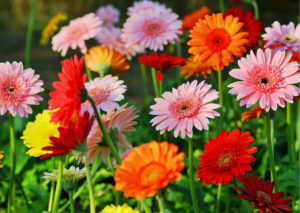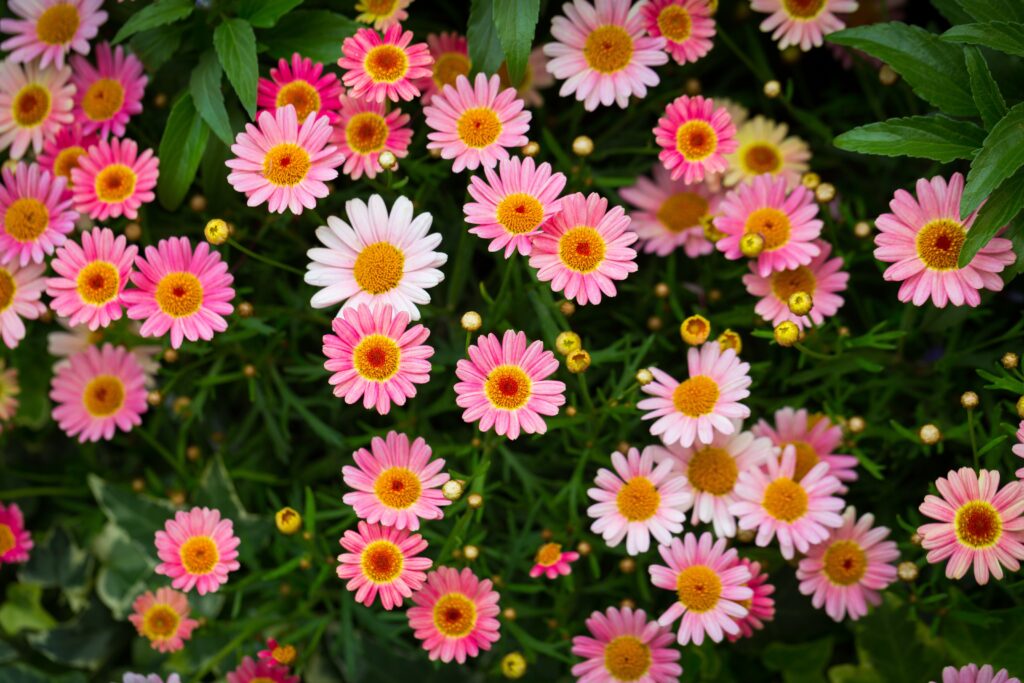Introduction
The Barberton Daisy, scientifically known as Gerbera jamesonii, stands as a testament to the joy of indoor gardening. This vivacious perennial brings a burst of color and vitality to any space, embodying the essence of the vibrant South African landscape from where it originates. This review offers a comprehensive look into the care and characteristics of the Barberton Daisy, ensuring your gardening endeavors are crowned with success.
Barberton Daisy (Gerbera jamesonii) Indoor Plant Details
| Key Specification | Description |
|---|---|
| Common Names | Barberton Daisy, Gerbera Daisy, Transvaal Daisy |
| Botanical Name | Gerbera jamesonii |
| Family | Asteraceae (Daisy family) |
| Plant Type | Herbaceous perennial |
| Mature Size | Typically 12 to 18 inches in height with a similar spread |
| Sun Exposure | Prefers bright, indirect light |
| Soil Type | Well-draining potting mix, ideally with added perlite or sand for aeration |
| Soil pH | Slightly acidic to neutral (6.1 to 7.5) |
| Bloom Time | Primarily in spring and summer, but can bloom multiple times a year with proper care |
| Flower Color | Wide range including white, pink, red, orange, and yellow |
| Hardiness Zones | Best as an indoor plant; can thrive outdoors in USDA zones 8-11 with protection |
| Native Area | South Africa |
| Benefit | Beautifies indoor spaces; known to purify indoor air by removing toxins like benzene and formaldehyde |
Plant Care
The Barberton Daisy is a delightful plant to care for. Its bright flowers and verdant leaves are a reward for any gardener’s efforts. However, like any living thing, it requires specific conditions to flourish. By understanding its needs and preferences, you can ensure that your plant remains healthy and vibrant.
Light Requirements
Sunlight plays a pivotal role in the life of the Barberton Daisy. This plant craves bright, indirect sunlight. A location near a south or west-facing window, shielded by a sheer curtain, is often ideal. Too much direct sunlight can scorch the leaves, but too little light may result in fewer blooms.
Soil Needs
When it comes to soil, the Barberton Daisy is relatively flexible but does prefer well-draining mixtures. A standard potting mix combined with some perlite or sand can provide the right balance. This ensures that the roots don’t sit in stagnant water, preventing root rot and other complications.
Watering Schedule
Watering the Barberton Daisy requires a delicate balance. Overwatering is a common pitfall; hence, it’s essential to wait until the top inch of soil feels dry to the touch before watering. Ensure the pot has drainage holes and always remove any excess water from the saucer to keep the roots healthy.
Temperature and Humidity Preferences
The Barberton Daisy thrives in temperatures between 65°F and 70°F during the day and a slightly cooler environment at night. Humidity levels should be moderate, mimicking its native habitat. If you find the air too dry, consider placing a humidifier nearby or occasionally misting the plant.
Fertilizer Recommendations
To support its vibrant growth and prolific blooms, consider feeding your Barberton Daisy with a balanced, water-soluble fertilizer every two to three weeks during its growing season. Always follow the manufacturer’s recommendations and avoid over-fertilizing, which can damage the plant.
Pruning Tips
Regular pruning keeps your Barberton Daisy in top shape. Remove spent flowers to encourage new blooms and periodically trim back any leggy growth to maintain a bushy appearance. Always use sharp, sterilized scissors or pruning shears to make clean cuts.
Overwintering Advice
As a perennial, the Barberton Daisy can survive winter months, but indoor conditions should be monitored. Ensure it receives adequate light and reduce watering slightly, as the plant’s growth slows during this period. Protecting it from drafts and sudden temperature drops is crucial.
Propagation Methods
This plant can be propagated from seed or by division. Sowing seeds is straightforward, but if you’re dividing an established plant, ensure each division has a healthy root system. Repot into fresh soil, water lightly, and await the emergence of new growth.
Types of Indoor Barberton Daisy Plants
The Barberton Daisy, or Gerbera jamesonii, is often recognized for its vibrant colors and iconic petals. However, it’s worth noting that the plant comes in a plethora of types, each bearing unique colors and petal arrangements:
- Single Flowered: These exhibit non-overlapping petals with a green eye at the center.
- Double or Duplex Flowered: Bearing a dense arrangement of overlapping petals without any visible eye.
- Crested Doubles: Showcasing rows of shorter petals surrounding the central eye, with the outermost ring having long petals.
- Full Crested Doubles: These have several rows of overlapping shorter petals with a green eye hidden deep within.
Regardless of type, all of them display a stunning color palette ranging from white, pink, and salmon to vibrant yellows, oranges, and reds.
Common Pests & Plant Diseases and Solutions
Like many indoor plants, the Barberton Daisy isn’t completely free from pests and diseases. Here are some common ones to watch for:
- Spider Mites: These tiny pests feed on plant sap, causing yellowing or stippling on leaves.
- Solution: Use insecticidal soap or neem oil, ensuring you spray the undersides of the leaves.
- Aphids: Small, pear-shaped bugs that suck plant sap and excrete honeydew, leading to sooty mold.
- Solution: Remove manually or use insecticidal soap.
- Powdery Mildew: Appears as a white, powdery substance on leaves.
- Solution: Improve air circulation, reduce humidity, and consider using a fungicide if necessary.
- Root Rot: Caused by overwatering, this is a fungal disease affecting the roots.
- Solution: Ensure proper drainage, reduce watering frequency, and if severe, consider repotting the plant.
How to Encourage Blooming
For a Barberton Daisy to display its majestic blooms, certain conditions need to be met:
- Light: Provide ample bright, indirect light.
- Watering: Maintain consistent moisture without letting the roots sit in water.
- Fertilization: Use a balanced fertilizer during the growing season to offer essential nutrients.
- Pruning: Remove spent flowers to encourage the growth of new blooms.
Common Issues with the Plant
While the Barberton Daisy is relatively hardy, it isn’t immune to issues:
- Leggy Growth: If the plant is stretching out or appearing sparse, it may need more light.
- Yellowing Leaves: Often due to overwatering or poor drainage. Ensure the soil dries slightly between waterings.
- Drooping: Underwatering or root rot might be the cause. Check the moisture level of the soil and adjust accordingly.
- Lack of Blooms: This could be due to insufficient light, extreme temperatures, or a lack of nutrients.
Incorporating this knowledge with the previously mentioned care details, nurturing a Barberton Daisy to its full potential becomes a rewarding experience. Understanding its needs and being vigilant about potential issues ensures that this plant remains a radiant jewel in any indoor garden setting.
Signs of a Quickly Declining Plant
A wilting Barberton Daisy, yellowing leaves, or lack of blooms can indicate underlying issues, often linked to watering, lighting, or pests. Regularly inspect your plant for signs of distress, and adjust care routines as needed.
Flourishing Finish
In conclusion, the Barberton Daisy’s captivating beauty is more than attainable with the right care. Armed with knowledge and dedication, gardeners can enjoy its lively blooms and vibrant presence year-round.
Frequently Asked Questions
Decode the magic of gardens with our guide to Landscaping Styles Frequently Asked Questions.
- Yes, in appropriate climates, this plant can thrive outdoors, particularly in USDA zones 8-11.
- With optimal care, the Barberton Daisy can bloom multiple times a year, primarily in spring and summer.
- While not considered highly toxic, it’s always best to keep plants out of pets’ reach to avoid any potential issues.
- Spider mites, aphids, and whiteflies can occasionally trouble the Barberton Daisy. Regular inspections and prompt interventions can keep these pests at bay.
Recent Posts
- Modern Mural Ideas Transforming Walls into Artworks
- Thematic Table Decor Dressing Your Table for Special Occasions
- Festive Lighting Ideas Brightening Your Home for the Holidays
- Biodegradable Decor Materials Choosing Earth-Friendly Options
- Personalized Space Decor Making Your Home Uniquely Yours
- New Year’s Eve Decor Ringing in the New Year in Style
- Transforming Junk into Decor Upcycling at Its Best
- Second-Life Decor Objects Giving Old Items New Purpose
- Unique Decoration Crafting Standout Ideas for Your Home
- Environmentally Friendly Styling Decor with a Conscience











